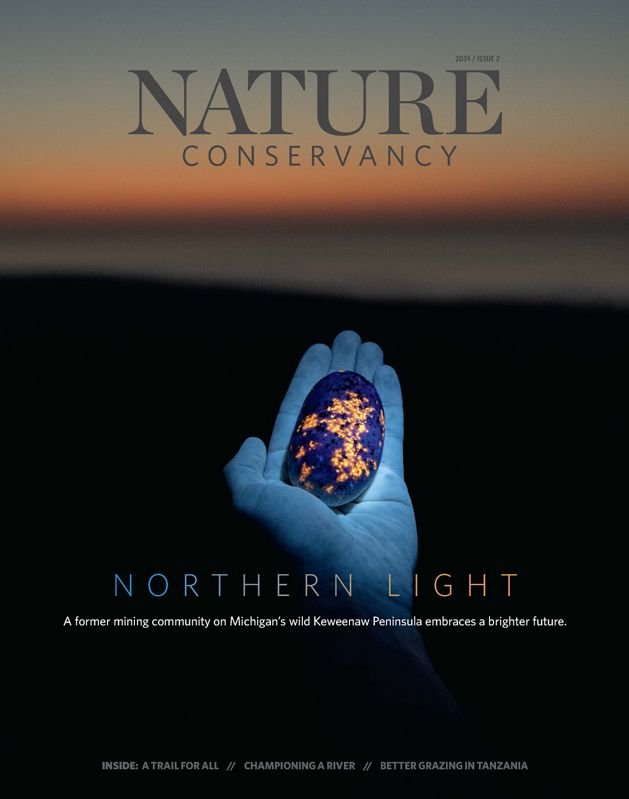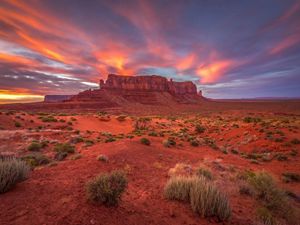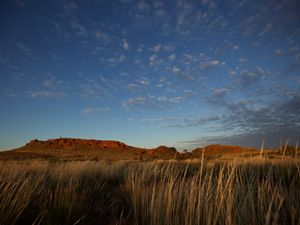
Going Big on Biodiversity
Large-scale biodiversity loss is not inevitable—if we can mobilize global efforts to protect 30% of lands and waters around the world by 2030.
Essay by David Banks, Chief Conservation Officer at TNC | Issue 4, 2024
Every fall in the mountains of western Mexico, the trees start to come alive. In the high-altitude forests of Michoacán and the state of Mexico, monarch butterflies arrive—slowly at first, then eventually by the millions. In time, the trunks of oyamel firs are covered by undulating carpets of white, orange and black, and the air fills with the flutter of countless wings.
The sight is just one part of one of the most astonishing insect migrations in the world, a 3,000-mile journey from the butterflies’ summer grounds in the northern U.S. and Canada to wintering sites in Mexico. From October through March, tens of millions of monarchs fly up to 100 miles per day to gather on roughly a dozen mountaintops until it’s warm enough to head back north.
Tens of millions may sound like a lot, but it represents a small fraction of what used to be. Researchers estimate that monarch butterfly populations have plummeted by more than 80% since the 1990s, when nearly 700 million butterflies made the journey. Decades of habitat loss, illegal logging and pesticide use, amplified by the effects of climate change, have taken a heavy toll, which explains why migratory monarch butterflies were declared a species of concern in 2022.
The monarch migration isn’t just an overwhelming visual spectacle of biodiversity. Butterflies are key pollinators for many crops and flowers, and serve as food for birds, small animals and other insects. Along the way, they touch down in a multitude of North American habitats, mate and produce caterpillars that transform into another generation that continues the migration. It will take three to four generations to complete the journey, and each step requires that they find the right conditions to survive. Everything is interconnected, and the monarch is just one piece in a much larger interconnected whole.
We have known for decades that protecting biodiversity is critical, not just for the sake of the environment but also for our own economy, health and culture. Every year it seems scientists issue more warnings that we are edging closer to a biodiversity crash. In my 30-year career at TNC, I have watched the loss of species and natural communities and it often feels like we are losing the battle. If we don’t stop undermining the natural systems that support over half of global GDP—nature supports $58 trillion dollars of commerce every year, according to a 2023 PwC study—the results could be disastrous. Species like monarchs are the threads that bind together the greater tapestry of life on earth—including us—and their loss would bring it all one step closer to unraveling.
Take many of the whale species of the Southern Ocean, which were hunted close to extinction in the 1800s and early 1900s largely for their blubber, which was rendered into valuable oil for lamps. Whale feces is rich in iron, which sustains the phytoplankton that serves as the main food source for almost all marine life—and plays a key role in removing carbon dioxide from the atmosphere through photosynthesis. With the whales decimated, phytoplankton levels fell, which in turn caused the population of krill to collapse. This meant less food for whales and other marine mammals, derailing the food chain in a vast swath of the ocean that is only starting to recover.
Quote
Species like monarchs are the threads that bind together the greater tapestry of life on earth—including us—and their loss would bring it all one step closer to unraveling.
But there’s still time to work toward a different future built on a foundation of biodiversity. The Nature Conservancy has a vision to stop this kind of damage and protect vital ecosystems on an ambitious new scale, starting with conserving 4 billion hectares of ocean—equating to three Mediterranean Seas—and 650 million hectares of land, an area twice the size of India.
Through partnerships with governments, stakeholders, and especially members and donors, TNC has launched exciting large-scale efforts that cover entire natural systems. We’re a core member of the Enduring Earth partnership, which is on track to protect and manage hundreds of millions of acres of critical habitat—forests, grasslands, oceans and rivers—around the world.
I recently visited Mongolia, where generous support from donors helped us secure an agreement with the government and other partners in April 2024 to unlock $198 million in conservation funding over the next 15 years. This deal will newly protect 56,000 square miles—an area approximately the size of Iowa—and help Mongolia achieve protection of 30% of the entire country.
And in Canada, we helped bring together support and funding for a First Nations-led initiative to improve the management of 38,000 square miles of culturally and environmentally significant ocean along the coast of British Columbia. Led by 17 First Nations, the Great Bear Sea project launches a new era of collaborative marine conservation and sustainable economic development, raising CA$260 million ($192 million) from the national and provincial governments and CA$75 million ($55 million) from private donors.
Save Wildlife
Help support lions, monarch butterflies and other threatened species by donating
DonateHealthy rivers play a fundamental role in protecting biodiversity by supporting nutrient cycling, fish movement, water filtration and flood control. That’s why we’re concentrating on increasing investment in nature-based solutions to protect rivers and streams. More than 50 TNC watershed investment programs across 30 countries like South Africa and Ecuador are providing financial support for ecosystem services. Out at sea, our work in setting up Blue Bonds in Belize, Barbados, Gabon and the Seychelles is helping fund the expansion of marine protected areas that total an area larger than the Gulf of America.
When I worked for our Africa program, we identified the Okavango Delta as one of the most biodiverse places to protect in Africa. We knew we had to work closely with local partners in several countries to be successful, and in 2018, TNC launched a project to ensure a sustainable future for the Okavango Delta in southern Africa. Every year this vast oasis in Botswana’s Kalahari Desert expands to 4,600 square miles, fed by seasonal rains in the lush highlands of Angola. During its “green season” the world’s largest inland delta draws one of the planet’s last truly epic animal migrations—an astonishing diversity of wildlife from African fish eagles and Nile crocodiles to the continent’s largest remaining population of savanna elephants.
Upriver from the Okavango—in the highlands that are the source of all water that runs into the delta—the country is considering large-scale hydro projects that could impact the ecosystem and disrupt wildlife and fish. With that in mind, TNC has partnered with national governments, local communities and global institutions to protect the greater ecosystem through smart development based on rigorous science and economic analysis—and, in the process, protect the delta and safeguard the livelihoods of the 1 million people who depend on the Okavango through fishing, agriculture, forestry and tourism.
Quote
We can still meet many of our goals for biodiversity protection while addressing our climate commitments. And the effect is cumulative, since biodiverse ecosystems are more resilient to climate change and help mitigate its worst effects.
There’s no time to waste: Warmer temperatures caused by human-induced climate change are already reducing the natural cycles of flooding that provide water to the delta. The Okavango is one of countless examples of how you can’t talk about biodiversity without including the global effects of climate change. Rising temperatures, ocean acidification and extreme weather events disrupt habitats and increase the risk of extinction of species already under threat.
We can still meet many of our goals for biodiversity protection while addressing our climate commitments. And the effect is cumulative, since biodiverse ecosystems are more resilient to climate change and help mitigate its worst effects, from healthy forests that act as carbon sinks to wetlands and coral reefs that help reduce flooding and storm surges.
The Nature Conservancy started as a biodiversity organization; it’s deep in our DNA, at the core of who we are. Over the years our mission has evolved: We once aimed to protect nature from people, and now we work to protect nature for people, balancing the needs of the natural world and human society. Conserving biodiversity has always been our bedrock. By investing in nature-based solutions and fostering partnerships across the globe, we’re weaving a stronger, more resilient future for the planet and ourselves.
Stunning Examples of Biodiversity and How We're Protecting It
Subspecies: African lion
Location: Sub-Saharan Africa
Conservation status: Vulnerable
Habitat: African savannas
Other species in this area: Zebras, leopards, giraffes, African elephants and many grazers
Tech Innovations Save Lives (Both Lion and Human)
African Lion
Every ecosystem needs apex predators to keep populations of other animals and plants in check. But changes in climate have caused droughts to intensify in East Africa, creating a conflict between people and big cats. Droughts disrupt watering holes that lions and other top predators use as hunting grounds. Zebras, gazelles and other grazing animals must find new areas to congregate. In response, some predators have learned to hunt domesticated animals. That often ends in pastoralist communities killing the big cats. So TNC partnered with organizations in Zambia and Kenya to protect both big cats and communities. By placing tracking collars on predators, organizations like Lion Landscapes and Panthera can warn communities when the cats roam near. This allows herders to be on alert and ward off predators trying to infiltrate protective enclosures for livestock. Those groups, alongside TNC, are also helping some communities build better enclosures to keep livestock—and predators—even safer.
Species: Reef manta ray
Location: Indonesia
Conservation status: Vulnerable
Habitat: Indian and Pacific ocean reefs
Unique habits: Keeps itself clean with the help of small fish and shrimp that feed on parasites on the manta’s skin.
Protecting Marine Habitats Helps Wildlife and Economies
Reef Manta Ray
More than 10 feet wide, the docile and graceful reef manta ray is a charismatic ambassador for Indonesia’s endless seascape. The Indonesian archipelago sits at the meeting point of currents from the Indian and Pacific Oceans. This makes it an area of extremely high marine biodiversity, hosting thousands of species of reef fish, corals, jellyfish, sea turtles, pelagic fish, sharks, whales, rays and much more. This natural abundance makes tourism and fishing two of the country’s strongest economic sectors. The Nature Conservancy and its main partner in Indonesia, YKAN, are supporting the government as it aims to grow the country’s total marine protected areas to 125,000 square miles—an area larger than Italy—by 2030. YKAN is currently assisting the government as it identifies the most important and sensitive habitats across the country’s marine areas and develops plans for managing protected areas, no-fishing zones and marine parks, while considering the needs of communities.
Species: Andean condor
Location: Western South America
Conservation status: Near threatened
Habitat: Range extends from 15,000-foot peaks of the Andes Mountains down to sea level
Other species in this area: South Andean deer, spectacled bears, mountain toucans and guanacos
Preserving Large Landscapes Gives Large Birds Room To Fly
Andean Condor
Andean condors—the largest flying bird in the world—can be found soaring above the peaks and valleys of their namesake mountain range from Colombia in the north to the southern reaches of Argentinian and Chilean Patagonia. They use their 10-foot-plus wingspan to ride air currents while flying more than 100 miles every day. But this iconic vulture is now threatened by habitat loss, the construction of new power lines and wind turbines, the onset of climate change, and poisoning from pesticides and lead shot from hunting. That is why TNC is working across South America to safeguard mountain grasslands, alpine areas and watersheds from overdevelopment. The Conservancy is protecting forest habitats, helping ranchers implement environmentally friendly grazing methods for sheep, and facilitating sustainable practices for soy production—all of which give the condor space to continue its awe-inspiring flights.
Species: Elkhorn coral
Location: Caribbean Sea and Gulf of America
Conservation status: Critically endangered
Habitat: Shallow coastal waters
Other species it supports: Spiny lobsters, reef fish, sea turtles, eels, sponges, octopuses and sharks
Planting New Corals Restores Damaged Reefs
Elkhorn Coral
The thick, complex branches of elkhorn coral helped build the colorful and astoundingly biodiverse reefs of the Caribbean over thousands of years. Today, these rich ecosystems—which harbor all manner of marine life, protect coastlines from storm surges and generate revenue from tourism—are under serious threat from global warming, pollution and overfishing. In response, The Nature Conservancy is working to protect coral reefs throughout the Caribbean. At the U.S. Virgin Islands Coral Innovation Hub, opened in 2021, 24 large tanks grow crops of new coral from fragments of wild parent colonies, including elkhorn, for restoration and outplanting. In Barbados, TNC secured $50 million in conservation and sustainable-development funding for the country to protect its oceans. Last year, TNC and its partners outplanted 16,850 corals in the Bahamas and Virgin Islands, and debuted CoralCarib, a new initiative focused on reef recovery in Cuba, the Dominican Republic, Haiti and Jamaica.
Species: Pygmy rabbits (Columbia Basin population)
Location: Washington
Conservation status: Endangered
Habitat: Sagebrush steppe in the Columbia River draining basin
Other species in this area: Big sagebrush, weasels, coyotes, owls, American badgers, hawks
Reintroducing Endangered Species Benefits Many Others
Pygmy Rabbits
In recent years, the smallest rabbit species in the U.S. has had a rough go. Weighing barely a pound full-grown, the endangered Columbia Basin pygmy rabbit has faced disease, inbreeding and the loss of its sagebrush-steppe habitat to development and wildfire. Washington state’s Department of Fish and Wildlife has given the rabbit a fighting chance through a captive breeding program at TNC’s Beezley Hills Preserve. The federal Conservation Reserve Program, which helps incentivize the protection of sagebrush habitat on private land, has also helped by creating a corridor of habitat for the rare rabbit in eastern Washington state. While the habitat protection has been a boon for the rabbits, many other species have benefited as well: The corridor has proved to be a lifeline for a number of animal species escaping the proliferation of wildfires in recent years throughout the Pacific Northwest.

Magazine Stories in Your Inbox
Sign up for the Nature News email and receive conservation stories each month.









